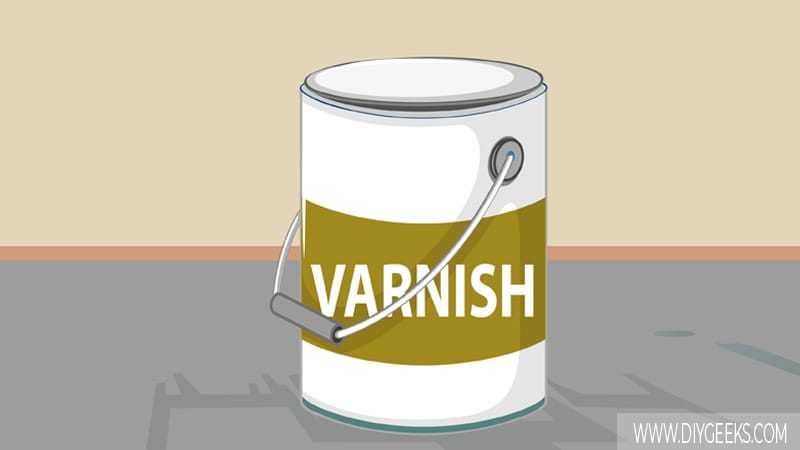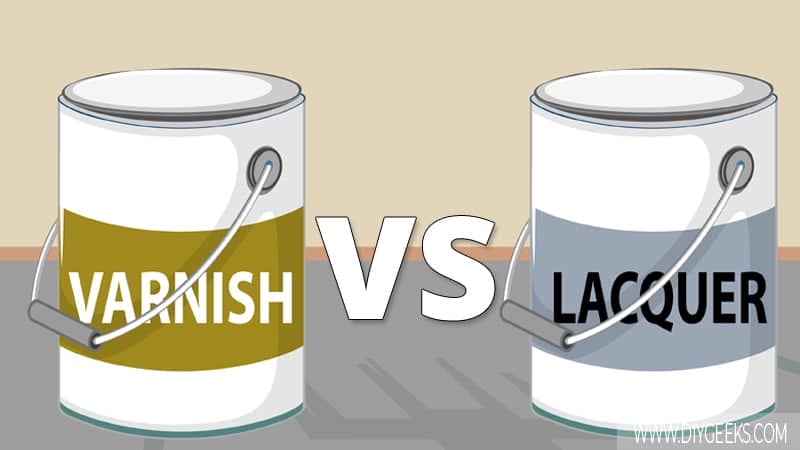Varnish is a protective coating that creates a moisture-resistant layer over surfaces and protects them. Lacquer is a protective coating that creates a finish that is resistant to wear and tear and low water exposure.
Varnish offers better wood protection and moisture resistance than lacquer. Lacquer has a thinner viscosity, dries faster, is cheaper, and is easier to apply than varnish.
What is Varnish?

Varnish is a traditional protective sealer that protects several surfaces from moisture, water, scratches, and weather elements. It forms a glossy transparent (or colored) coating that prevents water penetration.
Varnish is a topical finish that doesn’t penetrate the surface pores to adhere, it creates a moisture-resistant layer (barrier) over the surface top layer.
There are several varnish types that have different formulas and purposes, but all types create a moisture-resistant layer over surfaces.
What is Lacquer?
Lacquer is a clear or colored protective coating applied over several surfaces to enhance their appearance and protect them from wear and tear.
It’s known for its fast dry time, allowing you to apply multiple coats faster. You need between 2 to 5 lacquer coats for proper coverage and protection.
Lacquer creates a durable finish that is resistant to wear and tear and low moisture, but its finish can’t withstand high water exposure or high traffic. It often creates a glossy finish, but it’s available in different sheens too.
Different lacquer types include the following.
- Nitrocellulose lacquer.
- Pre-catalyzed lacquer.
- Catalyzed lacquer.
- Acrylic Lacquer.
Varnish vs Lacquer
The differences between varnish and lacquer are listed below.
Viscosity
Varnish has a thicker viscosity than lacquer as it’s formulated with more additives.
Sheen Level
Lacquer creates a more glossy finish than varnish as it’s formulated with more sheen (or gloss).
However, lacquer and varnish are both available in different sheens including matte, satin, eggshell, semi-gloss, and high-gloss.
Wood Protection
Varnish offers better wood protection than lacquer as it’s formulated with more protective additives and creates a harder finish.
Lacquer offers good wood protection from low water amounts, but its finish will get removed if exposed to constant water.
Moisture Resistance
Varnish offers better moisture resistance than lacquer as it forms a glossy layer (barrier) that prevents water penetration.
Lacquer offers good moisture resistance and can prevent low water penetration, but its finish will get washed off if exposed to constant water.
Price
Varnish is more expensive than lacquer, but it comes in large quantities that covers more surface. Lacquer usually comes in smaller cans that cost approximately $20, while varnish comes in larger containers that cost about $40.
Application
Lacquer is easier to apply than varnish as it has a thinner viscosity and dries faster, allowing you to apply multiple coats faster.
Varnish is harder to apply as it has a thicker viscosity that is harder to control and can leave brush marks behind.
Which Wood Finish Do You Need?
Before choosing a wood finish, consider the following things.
- Budget: Use lacquer if you have a low budget as it costs less. However, use varnish if you are sealing large surfaces as it comes in large containers.
- Application: Use lacquer if you don’t have experience on applying a sealer as it’s easier to apply.
- Protection: Use varnish if you want more surface protection from water, moisture, or scratches.
- Surface Type: Use lacquer for bare wood surfaces, and varnish for stained or painted surfaces.
- Interior or Exterior Surface: Use varnish for exterior surfaces and lacquer for interior surfaces.



